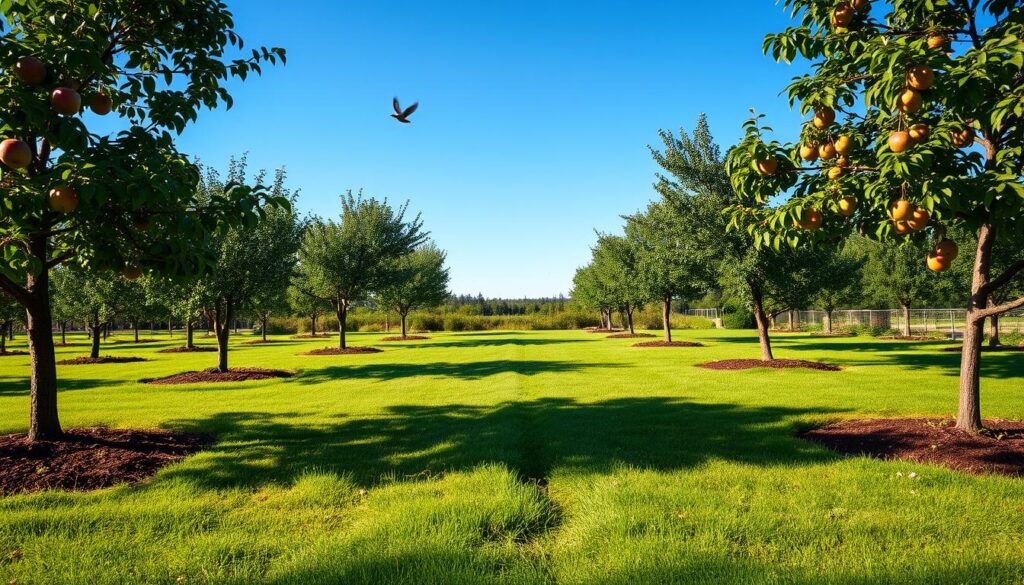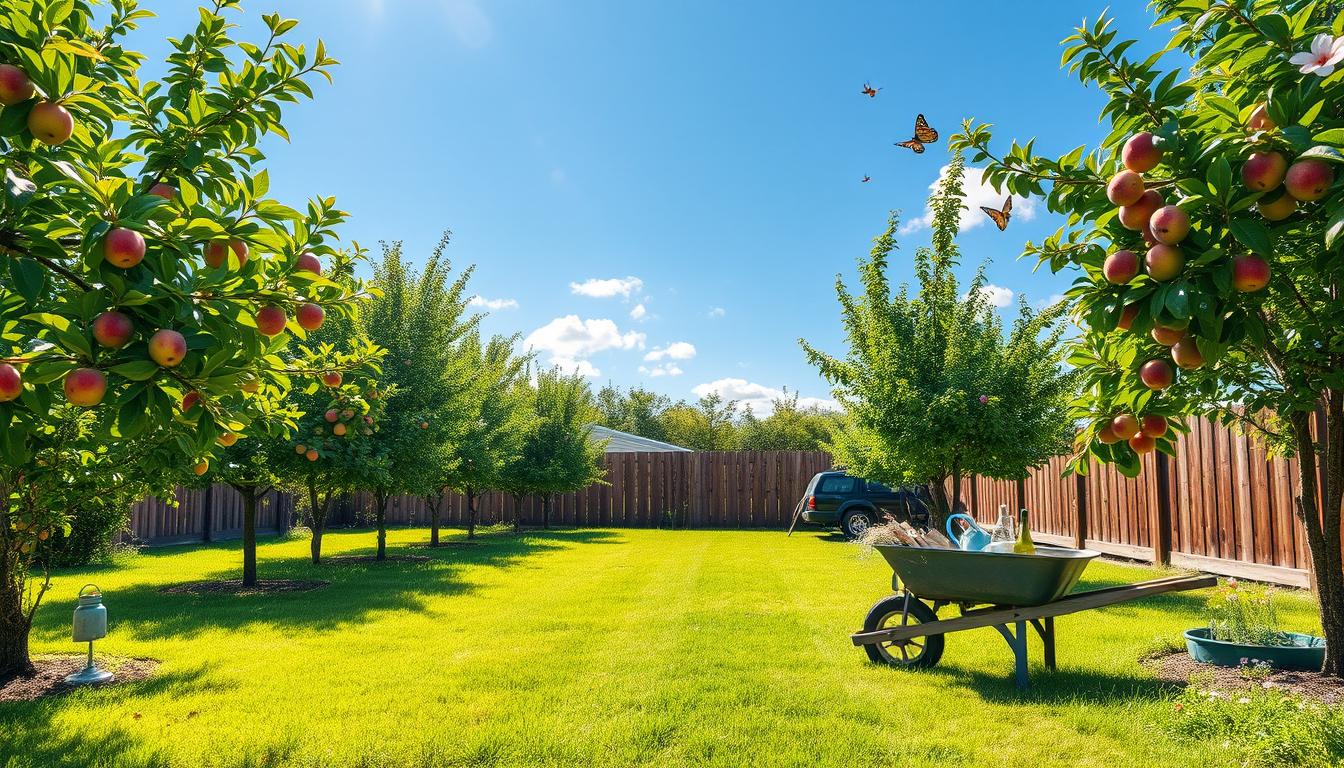Starting a backyard orchard is both exciting and rewarding. In this guide, I’ll cover the basics of starting a backyard orchard. I’ll also talk about the many benefits of growing your own fruit trees.
Enjoying fresh fruit from your own trees is empowering. It’s also good for the environment. Growing your own fruit can save money and bring joy.
Key Takeaways
- Understanding the essential spacing for different types of fruit trees is crucial.
- Pear trees, particularly the ‘Kieffer’ variety, are among the easiest to grow.
- Self-pollinating varieties, like fig trees and certain grape vines, simplify the process.
- Citrus trees thrive in USDA zones 8 through 11, offering easy cultivation.
- Peach trees are forgiving and suitable for slightly advanced beginners.
- Container gardening for fruit trees is possible with the right soil and drainage.
Understanding the Benefits of a Backyard Orchard
Having a backyard orchard brings many benefits. It’s great to have fresh produce right at home. This lets me make tasty dishes with fruits picked at the best time.
It also helps me eat healthier. Knowing where my food comes from adds a special joy.
Fresh Produce at Your Fingertips
Harvesting fruits from my garden is a joy. Imagine eating a fresh peach or using apples for pies. These moments show the backyard orchard benefits as I enjoy fruits without pesticides.
Having different fruit trees means I can try new flavors all year. It makes me feel closer to my food.
Environmental Advantages of Growing Your Own Fruit
A backyard orchard also helps the environment. Fruit trees clean the air by taking in carbon dioxide and making oxygen. They also provide a home for bees and butterflies, which are key to a healthy ecosystem.
Growing my own fruits helps biodiversity. It also cuts down on the carbon footprint from transporting food. My small effort can make a big difference.
| Advantage | Description |
|---|---|
| Fresh Produce | Enjoy tasty, organic fruits right from my backyard. |
| Health Benefits | Encourages healthier eating habits with easy access to fresh fruits. |
| Environmental Impact | Improves air quality and supports local ecosystems. |
| Biodiversity | Promotes a variety of plant and animal life through cultivation. |
| Carbon Footprint | Reduces greenhouse gas emissions linked to food transportation. |
How to Start a Backyard Orchard: Beginner’s Guide
Starting my backyard orchard begins with choosing the right fruits for my climate. I use local nurseries and the USDA Plant Hardiness Map to pick the best varieties. This knowledge helps me grow a bountiful harvest.
Choosing the Right Fruits for Your Climate
When picking fruits, I consider how they grow in my area. For example, hardy apple tree varieties like Arkansas Black or Ashmead’s Kernel fight off pests and diseases well. A mix of species makes my orchard richer and helps with cross-pollination, making fruits healthier and sweeter.
Fruit trees need 6 to 8 hours of sunlight a day. This is crucial for their growth.
The Importance of Heirloom Varieties
Adding heirloom varieties to my orchard has many benefits. They often resist diseases better and taste unique, improving my fruit’s quality. By choosing heirloom varieties, I support biodiversity and a healthy local ecosystem. Each tree adds to the orchard’s strength, showing that variety is essential.
Planning Your Backyard Orchard Layout
Creating a backyard orchard needs careful planning. First, I assess the space and choose the right trees. I look at my yard’s layout, sunlight, and any obstacles. This ensures my fruit trees grow well and produce plenty.
Assessing Available Space in Your Yard
I start by measuring my yard and noting any features. I consider the size of the trees I want, like dwarf or standard varieties. Each tree needs a certain amount of space:
- Dwarf trees: 8-10 feet apart
- Semi-dwarf trees: 12-15 feet apart
- Standard trees: 18-20 feet apart
This helps me plan the orchard layout. It makes sure each tree gets enough sunlight, air, and water.
Creating a Planting Map
With a clear yard layout, I create a planting map. It shows where each tree will go based on sunlight and water needs. For example, I put the Benton cherry and Santa Rosa plum in sunny spots.
The Glohaven peach and Spitzenburg apple come next. I leave room for the Sunflower pawpaw tree to grow. This map helps me water deeply and plan for future growth.
This careful planning leads to a fruitful harvest and a beautiful orchard. It’s all about thoughtful planning and preparation.
Selecting the Best Location for Your Orchard
Finding the right spot for your backyard fruit trees is key to their success. Sunlight and soil conditions are crucial. Knowing these will help you create a great garden.
Sunlight Requirements for Fruit Trees
Fruit trees need 6-8 hours of sunlight a day to grow well. I should plant them where they get the most sun. Planting in north-south rows helps more than east-west rows.
This sunlight is important for healthy fruits.
Soil Conditions and Drainage
Good soil is essential for a successful orchard. The best soil is deep, well-drained, and aerobic loam, at least three feet deep. Testing the soil years before planting helps.
This lets me adjust the soil for my trees’ health. Well-drained soil prevents waterlogged roots, which slow growth.

| Factor | Recommendation |
|---|---|
| Sunlight | 6-8 hours daily |
| Soil Type | Aerobic loam, well-drained |
| Drainage Assessment | Prevent waterlogging |
| Slope | 4-8 percent for frost protection |
| Tree Orientation | North-south rows preferred |
With these tips, I can pick the best spot for my orchard. The right sunlight and soil will help my fruit trees thrive. For more gardening tips, check out GardenBeginner.com.
Choosing the Right Varieties of Backyard Fruit Trees
When picking fruit trees for my backyard, I look at two main things: pollination needs and disease resistance. Knowing these helps my trees grow well and avoid problems.
Pollination Needs and Self-Fertile Options
Some trees need another tree to pollinate for good fruit. For example, many apple trees like ‘Fuji’ or ‘Granny Smith’ do better with a neighbor. But, some trees like figs can pollinate themselves. It’s key to know these pollination needs, especially if space is tight. Dwarf trees are great for small spots and might need a friend tree for pollination sometimes.
Recommended Disease-Resistant Varieties
Choosing disease-resistant varieties helps my orchard stay healthy and long-lasting. Pear trees, like ‘Kieffer,’ are strong against diseases and need less spray. They’re a smart pick for a low-maintenance orchard.
Apple trees like ‘Anna’ and ‘Ein Shemer’ are also good choices. They do well in many places. And citrus trees are perfect for zones 9 to 11, offering plenty of fruit.
Essential Tools and Materials for Planting
Starting my backyard orchard needs a clear plan and the right tools. The right equipment is key for a smooth planting process. It ensures my plants grow well. Here, I list the tools I need and talk about soil amendments for strong growth.
Gardening Tools You Will Need
For my orchard, I picked out some key gardening tools:
- Hand trowel: Great for digging, planting seeds, and weeding.
- Hand fork or cultivator: Good for removing weeds and loosening soil.
- Long-handled shovels and spades: Ideal for digging holes, cutting roots, and moving soil.
- Garden rake: Useful for leveling soil and smoothing compost.
- Hand pruners or pruning shears: Important for trimming branches and keeping plants healthy.
- Wheelbarrow: Essential for moving soil, compost, and other heavy stuff.
- Watering can: Great for watering small areas.
- Garden hoe: Important for removing weeds and making furrows for planting.
- Leaf rakes: Lightweight and good for cleaning up leaves and mulch.
- Other tools include gardening gloves, garden scissors, hori-hori knife, garden hose, and soil monitor.
Soil Amendments for Healthy Growth
While tools are important, the right soil amendments are crucial for my trees’ health. I focus on:
- Compost: Adds organic matter, improving soil structure and nutrient content.
- Natural fertilizers: Provide specific nutrients needed in the early growth stages of my trees.
Using the right planting materials and amendments gives my orchard a strong start. This sets my trees up for success. Preparing well with the right tools and amendments greatly improves my orchard project’s outcome.
Planting Your Backyard Orchard: Step-by-Step Guide
Planting a backyard orchard needs a careful plan. This guide helps you prepare the soil and plant trees right. A good start means healthy trees and lots of fruit.
Digging and Preparing the Soil
Soil is key for a great orchard. I look for soil that drains well and is rich in nutrients. If it’s too clay-heavy, I mix in peat to help it drain better.
I make holes three times bigger than the root ball. This gives the roots room to grow. After planting, I add two to three inches of compost around the trunk. This helps the tree grow strong.
| Spacing | Tree Types | Recommended Distance |
|---|---|---|
| Between Trees | Regular Fruit Trees | 12-14 feet |
| Between Rows | All Types | 18-20 feet |
| Spacing for Dwarf Varieties | Dwarf Trees | 10 feet |
Proper Planting Techniques for Young Trees
When planting, I moisten the roots with a mud slurry. This helps avoid air pockets. I plant the trees straight or slightly leaning towards the wind for stability.
It’s important to space trees well to prevent competition. This helps them grow strong and healthy. Water them regularly, aiming for an inch a week. Use high-nitrogen fertilizers before they bloom to boost growth.
By following these steps, your orchard will thrive. You’ll enjoy fresh fruits for many years. For more tips on growing fruit trees, check out this link.
Watering and Irrigation Tips for Your Orchard
Water management is key to a successful backyard orchard. Each fruit tree has its own water needs. Knowing these needs and how to meet them is crucial. The right watering tips and irrigation systems can boost your trees’ health and productivity.
Understanding the Water Needs of Different Fruits
Every fruit tree is different. Apple trees need careful watering to avoid too much water. Almond trees need about 1 gallon of water daily. Pear trees are happy with just 1 gallon per week.
Peach trees grow fast and need lots of water, especially when it’s dry. Knowing these water needs is essential for healthy trees and good fruit.
Setting Up a Reliable Watering System
The right irrigation system is important for saving water. Drip irrigation is the best, as it helps water soak into the soil. It delivers water right to the roots, keeping them moist.
Overhead irrigation uses more water and is less efficient. Sprinklers can also waste water, especially under trees. Micro-irrigation systems with micro sprinklers are a better choice for saving water.

When starting your orchard, think about tree sizes too. Dwarf trees are 8 to 10 feet tall. Semi-dwarf trees grow to 12 to 15 feet. Standard trees can get over 25 feet tall.
Understanding these differences helps you set up a good watering routine. For more tips, check out my watering and irrigation tips. Proper care now will pay off as your orchard grows.
Backyard Orchard Maintenance and Care
Keeping a backyard orchard healthy is key. I focus on fertilizing and managing pests to keep my trees thriving. This care ensures a rich harvest for me to enjoy.
Fertilization Best Practices
Using the right fertilizers is crucial for my trees’ growth. I watch the nitrogen levels closely to avoid too much growth. This makes pruning easier later on. I also keep the soil well-drained and slightly acidic, helping my trees absorb nutrients better.
- Fertilize in early spring to support new growth.
- Utilize organic fertilizers to promote healthy soil ecology.
- Conduct soil tests regularly to adjust nutrient levels accordingly.
Pest Management Strategies
Managing pests is essential for my orchard’s health. I use a mix of early detection and organic treatments. Regular checks help me catch pests early, reducing the need for harsh chemicals. This keeps my orchard safe for bees and other helpful insects.
- Implement regular maintenance to identify plant health issues early.
- Encourage natural predators by creating habitats that support them.
- Utilize organic solutions such as neem oil or insecticidal soap when problems arise.
Harvesting and Enjoying Your Fruits
After planting and caring for your backyard orchard, the moment of fruit harvesting comes. Knowing when to pick is key for the best taste and quality. Each fruit type has its own signs of ripeness, so it’s important to know these for your orchard.
Determining Ripeness and Harvest Time
To get the most out of your fruit, look for signs of ripeness. Here are some important things to check:
- Color: Fruits often change color when they’re ripe. For example, green apples turn yellow or red.
- Texture: A bit of softness can mean fruits like peaches and pears are ready.
- Smell: A sweet, fragrant smell usually means fruits like melons are ripe.
- Time of Year: Knowing when each fruit is in season helps me plan better. Most fruits have a specific time when they grow best.
Storage Tips for a Longer Shelf Life
After picking my fruits, storing them right is crucial to keep them fresh longer. Here are my best tips for storage:
- Cool, Dry Places: Keeping fruits like apples and pears in a cool, dry spot helps prevent spoilage.
- Airtight Containers: Using airtight containers for berries keeps them from getting soggy and extends their life.
- Refrigeration: Some fruits, like berries and grapes, stay fresh longer in the fridge.
- Regular Check-ups: Checking stored fruits often helps catch any that are getting too ripe before they spoil the rest.
Using these practical tips lets me enjoy my fruit more and waste less. Knowing how to harvest and store fruits smartly makes my orchard experience even better.
Common Mistakes to Avoid When Starting an Orchard
Starting an orchard can be rewarding but also comes with challenges. Many beginners make common mistakes, especially about soil testing and pollination. Knowing these mistakes can help improve fruit production.
Neglecting Soil Testing Before Planting
One big mistake is not doing soil tests before planting. Knowing your soil’s pH and nutrient levels is key for healthy trees. Trees need specific pH levels to grow well.
Soil that drains well is crucial. It should drain at least 2 inches per hour for good growth. Skipping soil tests can lead to nutrient shortages, hurting fruit yields.
Overlooking Pollination Needs
Another big mistake is ignoring pollination needs. Many fruit trees need other trees to set fruit. Without the right pollinators, harvests can be disappointing.
It’s smart to research each tree’s pollination needs. This way, you can choose trees that work well together in your orchard.
Conclusion
As I wrap up this guide on backyard orchards, it’s clear that it’s more than just planting trees. It’s about connecting with nature. Growing fruit trees takes time, often years before they produce fruit. But the joy and satisfaction of growing your own garden make it all worth it.
Every step in this journey is rewarding. You get to learn and experiment while enjoying fresh, homegrown produce. This process is full of opportunities to grow and enjoy your garden.
In this guide, I covered key points like giving trees enough space and understanding soil. I also talked about the importance of good drainage and biodiversity. Choosing fruit trees that fit your local climate is crucial for their health and yield.
Creating a backyard orchard is an investment in your environment and health. By caring for your fruit trees, you’re not just feeding your family. You’re also helping local biodiversity and food sustainability. I encourage everyone to start this journey of growth and harvest. It will enrich your life in many ways.



Leave a Reply